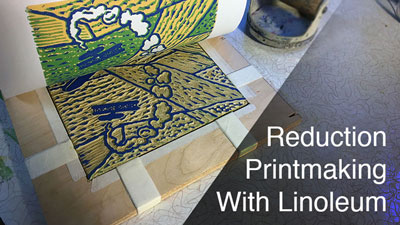
It is important for us to be able to evaluate art. If we’re artists, we must recognize what is good and what is bad, so that we may become more successful at our craft.
If we’re patrons, we must be able to discern success from failure as well.
If we’re teachers, we must teach our students the mental process that people naturally go through when they look at a work of art. This way our students are better equipped to create successful artwork on their own, and understand why and how their artworks are digested.
See also: The Importance of Critique
How Do You Evaluate Art?
This question is answered differently by just about everybody. What really constitutes “good” art? We all know that opinion plays a major role in what a person may feel is “good”. But should it? Should there be a defined framework for what good artwork is? Should there be a standard? What would that standard be?
I often ask students, “What is Art?” The range of answers I get to this question is staggering. One answer keeps rearing its ugly head, however. “Art is whatever you want it to be.”
What??? Is that what art is? Whatever you want it to be?
My skin cringes when I hear this statement. Why? Art is NOT whatever we want it to be. It is a discipline that requires study, dedication, and practice. It takes knowledge to produce good artwork.
How can we evaluate art when we think it is “whatever”?
Evaluate yourself before you evaluate art. Do you like the expressive qualities of a work art, the message it conveys, and the emotional qualities within? Do you find that artworks that strive for realism suite your fancy? Do you place most importance on the use of color theory, use of line, composition, shape, form and so on?
Or perhaps you find all of these attributes to be important in good artwork?
We can categorize ourselves according to how we evaluate art.
Are you an Emotionalist?
If you find the expressive qualities of an artwork to be most important, you may be an emotionalist. An Emotionalist looks for the message the artwork conveys, evaluates how the artist has communicated this message, and proceeds to evaluate the artwork’s success on this notion.
Are you a Realist?
Do you find the realistic qualities of a work of art to be the most interesting? Are you the type that looks at a work of art and says, “That doesn’t look like a person”? Or maybe you look at a drawing and become amazed at how much the artist has made it look like a photo. If this describes you, then you probably are a realist and evaluate the success of artwork based on its realistic qualities.
Are you a Formalist?
Do you look for the color scheme, the use of the elements and principles of art, the composition and other formal qualities to evaluate the artwork? If you do, then you probably are a formalist.
Evaluating artwork is different for everyone. We will all look and see artwork differently. We will find merit in different places because we are different people. Should there be a standard for evaluating art? What do you think? Are you a formalist, emotionalist, realist, or a mixture?
The Steps to Critiquing Art
There is an accepted four step process for critiquing art. We generally go through these steps when we evaluate a work of art in our minds, but it’s helpful to know exactly what is happening. And if you’re teaching this process to students, it’s important to teach them this process so that can use it to evaluate their own works and the works of others.
Understanding the steps to critiquing art allows you to evaluate a work in more objective manner. So whether you’re an emotionalist, realist, or formalist, you can still appreciate the art – even though it may not be in the style that you enjoy the most.
The four step approach is…
- Description
- Analysis
- Interpretation
- Judgment
When I teach the steps of art criticism to my students, I have them say this word – “DAIJ”. Yes, I know-“DAIJ” is not a real word. I am very ridiculous about it. I say silly sentences like, “Have you guys played any DAIJ ball this summer?” The students may think that I’m crazy, but they remember that word-“DAIJ”. DAIJ is simply an acronym for the steps of art criticism.
Description
The first step in art criticism is description. When we look at a work of art, our minds naturally take notice of the general information that’s present. If we take The Mona Lisa for example, we notice, “Hey, this is a painting of a woman.”
We start with just a simple statement of observation. We should try to keep ourselves from judging the quality of the work until we have gone through all of the steps.
Analysis
Analysis refers to how the elements and principles of art are used in the work. In this step, our minds take in the lines, values, and colors of the artwork. We also may take notice of the balance, proportion, rhythm, and unity found within the work.
See also: Composition in Art
In a critique, students should point out what is happening with these specific elements and principles. Many times, the formal qualities of the art are what makes the art successful. Students should understand how these qualities work and what makes them successful in artwork. They should also be able to discern when these formal qualities are unsuccessful as well.
Interpretation
Often times, we’ll instinctively skip to this step. We look for meaning in everything, so this is perfectly natural. In this step, we explore the meaning of the art. What is the artist trying to communicate to us? There are no wrong responses here. The artist may have a meaning that they intended in the work, but how we interpret it is completely up to us.
Judgment
The last step in art criticism is judgment. Is this work of art successful? If we’re teaching students, it;’s important to guide them in this step. Remind students that the work of art may not be their favorite, but it may still be successful. This way, we teach students to appreciate all forms of art, even if we personally do not like it.
Conclusion
Understanding the steps to art criticism and implementing them in a structured way in critique, will lead to stronger artworks. If you’re teaching students, then these steps are vital. These steps help us to appreciate all forms of art, including the works that we may not appreciate at first glance. All forms of art have their place and all deserve a fair approach of evaluation.
If so, join over 36,000 others that receive our newsletter with new drawing and painting lessons. Plus, check out three of our course videos and ebooks for free.
Lesson Discussion
Comments are closed.






good article Matt